February 2002 Vol. 39 No. 2 - Original Location
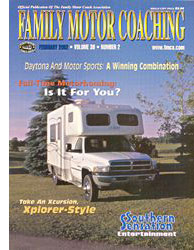 Xplorer Motor Homes sets this 21-foot type C apart from the rest by building a convenient, practical house on a fuel-efficient Dodge truck chassis. This article was written previous of the purchase by Startracks Custom Vehicles in Elkhart, IN.
Xplorer Motor Homes sets this 21-foot type C apart from the rest by building a convenient, practical house on a fuel-efficient Dodge truck chassis. This article was written previous of the purchase by Startracks Custom Vehicles in Elkhart, IN.
By K. Stephen Busick, F45180
The new Xcursion from Xplorer Motor Homes of Brown City, Michigan, is striking in appearance, features, and performance. This type C coach attracted attention wherever we took it. The aluminum-framed, fiberglass-skinned motorhome is perched atop a Dodge Ram chassis cab, rather than the more common Ford or Chevrolet cutaway foundation with a van-type front.
Although the cab portion of this motorhome is reminiscent of a pickup camper, it is a true motorhome that enables its owners to meet the requirements for FMCA membership. And, like every other motorhome, the 21-foot Xcursion is not the perfect coach for everyone. But it offers many nice features in addition to those that come with this unusual chassis, and will, I predict, find a faithful following among RVers looking for a combination of luxury, convenience, and practicality.
When I picked up the coach at the Xplorer factory in Brown City, David Bockstanz, president of Xplorer, commented that the coach is extremely simple to drive, because "everyone can drive a pickup." I think he is right. The Xcursion offers one of the most relaxing drives of any coach I have piloted. My wife and copilot, Linda, said that she found riding in the Xcursion very reassuring, whatever the traffic conditions or type of road.
Our test coach was a 2001 model. However, company officials noted that very few changes were implemented in this model for 2002. They also noted that three new Xcursion models join the ranks for 2002: 22½-foot and 25-foot models built on the Dodge chassis, and a 26½-foot model built on a Ford chassis, the latter featuring a power slideout. In addition, the Xplorer is available in Mopar four wheel drive.
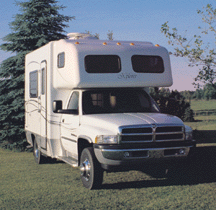 Entering and exiting the Xcursion through any of its three doors is easy. A Kwikee automatic electric step is standard, to make the task still easier. Getting into and out of the driver's and passenger's seats is equally simple thanks to the standard fiberglass running boards and remote keyless entry. Two factory-installed assist handles in the cab make entry for the passenger even more convenient.
Entering and exiting the Xcursion through any of its three doors is easy. A Kwikee automatic electric step is standard, to make the task still easier. Getting into and out of the driver's and passenger's seats is equally simple thanks to the standard fiberglass running boards and remote keyless entry. Two factory-installed assist handles in the cab make entry for the passenger even more convenient.
The cab offers an abundance of legroom, because the Magnum V-10 310-horsepower gasoline engine is well in front of the driving compartment. This not only makes the seating spacious but also keeps noise and heat levels down. It also means that work performed on the engine will be done outside the coach. You should never have to be concerned with service technicians' footprints and greasy handprints on the inside of the coach. The Xcursion also may be equipped with a Cummins 5.9-liter diesel engine.
Because the cab's heater, air conditioner, and all instrumentation are factory equipment, the availability of parts, as well as windshields, door glass, and other cab parts, should not pose a problem wherever the owners may travel in North America.
Electric windows and power door locks are standard equipment, as is the AM-FM radio with cassette, CD player, and equalizer. A convenient switch allows the radio to be powered by the two Interstate house batteries when the ignition is off. Six speakers, including two in the very rear of the coach, allow coach occupants to enjoy music throughout the vehicle.
One thing that I did find to be a minor inconvenience was the absence of power mirrors. The large foldaway mirrors on the coach do give a wonderful view of what is happening to the sides and the rear, but power mirrors would be simpler when switching drivers and could result in safer operation. When I asked Joe Murray, senior vice president of Xplorer, about this, he told me that he has been looking for a power mirror supplier for this chassis, but as of the time I spoke with him, he had not located one. On the positive side, when the coach is parked, the mirrors can be rotated parallel to the ground, and thus become more compact. Naturally, they should be returned to their original position before the motorhome is driven again.
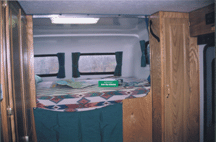 Moving between the cockpit and the remainder of the motorhome is easy, thanks to a large, hinged cutout in the cab-over bed area. We were somewhat concerned that when this cutout was returned to its flat position, the hinge might make anyone sleeping on it uncomfortable; however, that was not the case. We found the bed to be very comfortable and, with the sliding windows on each end of the cab-over area, it should remain pleasant and airy, even if the air conditioner is not on. Linda, who had polio as a child and wears a leg brace, found climbing into and out of the bed easy, thanks to a built-in step and a firmly attached assist handle. Company officials note that the floor-to-bed height is considerably lower than that found in a conventional type C cutaway chassis.
Moving between the cockpit and the remainder of the motorhome is easy, thanks to a large, hinged cutout in the cab-over bed area. We were somewhat concerned that when this cutout was returned to its flat position, the hinge might make anyone sleeping on it uncomfortable; however, that was not the case. We found the bed to be very comfortable and, with the sliding windows on each end of the cab-over area, it should remain pleasant and airy, even if the air conditioner is not on. Linda, who had polio as a child and wears a leg brace, found climbing into and out of the bed easy, thanks to a built-in step and a firmly attached assist handle. Company officials note that the floor-to-bed height is considerably lower than that found in a conventional type C cutaway chassis.
A headboard with a shelf is molded into the sleeping area, and atop it are two individual gooseneck reading lights. These and an overhead fluorescent light provide illumination for the area. The lights in the sleeping area -- and all other lights in the coach except the wall sconces -- are controlled by wall switches.
For those who need additional sleeping space or prefer not to climb into the cab-over bed area, a second sleeping area can be made by converting the 75-inch-by-38-inch dinette.
The streetside bath is small, as it should be in a coach this size. The toilet sits parallel to the streetside wall. The bathroom is enclosed by two small doors, which avoids the intrusion into the living space that one big door would make. A watertight door under the sink promises to keep the switch for the holding tank heaters and anything stored there dry when the hand-held shower is used. A built-in makeup cabinet on the outside wall might not fare as well, however, and would benefit if the shower curtain encircled three of the walls. But with a bath this size, it is very possible that the shower would not be used frequently, as the coach owner may opt to use a campground shower instead. A six-inch circular fan provides ventilation in the bath.
Immediately aft of the bath is a 20-inch-wide, 42-inch-high hanging wardrobe. Above the wardrobe is a storage cabinet with receptacles for 110-volt and 12-volt electricity as well as the Winegard television antenna that sits on the roof. An optional television is available. If ordered from the factory, it is mounted on a swiveling, slideout base so that it can be viewed throughout the coach.
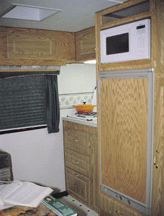 The galley is next along the street-side wall. It contains a Wedgewood two-burner cooktop, an optional GoldStar microwave oven, and a 5-cubic-foot Dometic Freedom LP-gas and electric refrigerator. A white single-handled faucet and sink complete the compact food center. A cutting board atop the sink does increase counter space, but since the dinette is only a couple of steps away, the table there seems to be a natural place to perform most of the tasks associated with food preparation.
The galley is next along the street-side wall. It contains a Wedgewood two-burner cooktop, an optional GoldStar microwave oven, and a 5-cubic-foot Dometic Freedom LP-gas and electric refrigerator. A white single-handled faucet and sink complete the compact food center. A cutting board atop the sink does increase counter space, but since the dinette is only a couple of steps away, the table there seems to be a natural place to perform most of the tasks associated with food preparation.
The top of an interior-exterior storage compartment behind the dinette became a natural spot for storing food and other items when we were parked. This compartment is lockable from the outside. A four-shelf pantry is situated just inside the coach door. When I first saw its location, I thought that it was unfortunate that it couldn't be nearer the galley. But, after I realized that the pantry in most stationary homes is farther away from the food prep area than this one, it made perfect sense that it be placed where it is. It is convenient enough for a chef, and because it's near the door, it's ideal for storing items you'll use outside.
A Fan-Tastic Vent ceiling fan with a built-in rain sensor is located near the rear of the coach. It should be especially helpful for removing any cooking odors or excess heat.
Large overhead cabinets line the curb side of the coach, and additional cabinets hang across the back and over the galley. The cabinets are large enough that aftermarket shelves could be placed in them to customize the storage capabilities to the users' preferences. I noted that the cupboard doors are perfectly aligned -- a very nice touch, indeed.
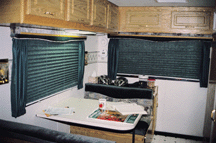 These large cabinets are possible in part because of the relatively high sidewalls in the coach. The 11,000-Btu Duo-Therm Penguin air conditioner is recessed into the ceiling, so that ample headroom remains nearly constant throughout the living area of the Xcursion.
These large cabinets are possible in part because of the relatively high sidewalls in the coach. The 11,000-Btu Duo-Therm Penguin air conditioner is recessed into the ceiling, so that ample headroom remains nearly constant throughout the living area of the Xcursion.
The Atwood Hydro Flame 16,000-Btu forced-air furnace did a great job of quickly removing the chill of the Michigan days and nights. Spray urethane foam insulation with an R-18 rating is used in the sidewalls, roof, and rear, and helps keep the coach comfortably warm or cool as needed.
A storage space is available under the dinette's front seat. The dinette cushions are held in place with hook-and-loop fasteners and did not move. However, since the only way to get to the storage is by removing the cushions, it did make for a minor inconvenience when access to that area was needed.
Behind a hinged door under the rear dinette seat is the 36-gallon fresh water tank and the Shurflo water pump. This is a very convenient location, because the water fill is on the outside wall by the fresh water tank. I like the fact that it is behind a locked cover to help prevent the accidental or malicious introduction of gasoline or other inappropriate material into the water system.
Jalousie-type windows are located next to the dinette. They can be left open in the rain to allow needed ventilation.
The pull-down shades on the dinette window and rear window did a good job of controlling light and masking the interior at night. A mini-blind covers the galley window, and dual-track sliding curtains provide privacy in the cab-over sleeping area.
The 6-gallon Atwood propane water heater features a Motoraid heat exchanger that uses the warmth generated by the engine cooling system to heat water. This feature not only helps cool the engine, but it also saves LP gas and provides the luxury of having hot water at the end of a day of driving. Bypass valves and drain valves for the water system are easily accessible behind a door in the galley.
The floor of the coach is covered with vinyl that coordinates well with the interior. Although we did use throw rugs that we would shake out occasionally, the vinyl could be easily cleaned. Naturally, the driving compartment has carpeted floor mats.
A decorative border on the walls lends a nice touch, as do the wall sconces.
Looking at the Xcursion from above is impressive; the only seam you can detect is where the cab-over area attaches to the main body. Because the body is one piece from the floor up, and the cab section is also one piece, no seams exist in places where other motorhomes might have them, such as where the roof would be joined to the walls. This was especially appealing to me, as I am currently trying to find a leak in my own coach. If I had a seamless coach body, I would have one less task ahead of me.
While looking at the roof, I also examined the 12-inch-by-24-inch solar panel placed there. A voltmeter that indicates the solar panel's charging status is located conveniently above the coach door, and I noticed that it usually indicated a charging condition during daylight hours. This was occurring although the days were very overcast and we were parked in a heavily wooded area.
A built-in rear "trunk" can hold a small toolbox, some oil, and other maintenance items that are sometimes difficult to store. Two removable plastic bins are located there for additional convenience. The handle for the two BAL stabilizing jacks is stored there, as is the handle for the coach jack. The actual vehicle jack is located under the passenger seat. Total exterior storage for the coach is listed as 23 cubic feet.
Although the coach sides are curved, the entrance door is straight. Thanks to neat sculpting of the body, a standard RV door can be used instead of a custom-made curved door. This allows all of the benefits of a curved body without the added expense of a custom-made door if it should ever need to be replaced.
High on the back of the coach is a combination third brake light and cargo light assembly. The inner part of the light adds safety by allowing traffic to know the coach is slowing, even if they are not able to see the regular taillights on the coach. This same feature is used on some delivery trucks. Each end of the light assembly is a clear light that is controlled by a switch on the inside wall of the trunk. This illuminates the area behind the coach, including the location for the crank-down spare tire.
Another storage compartment can be accessed through a door on the outside and inside via a door behind the dinette. We found that folding chairs easily fit into this area. This compartment, like most of the compartments on the coach, is illuminated -- another nice touch.
Xplorer has solved the problem of how to hold storage compartment doors open by placing the door hinges on the bottom. The doors do not touch the ground, and if a door should come unlatched while traveling, I doubt that it would be more likely to spill its contents than an unlatched door with hinges at the top. This arrangement makes it possible for water deflectors to be placed above areas that need to be kept dry. They seemed to do the job, because I found no indication of any water leaking into the compartments.
Anyone who has wrestled a cold, stiff, uncooperative electrical cord into a coach will appreciate the detachable 30-amp power cord. With a Marinco exterior inlet, electrical service hookup and disconnect promises to be fast and easy, whatever the weather.
The Xcursion we reviewed was not equipped with a generator, but Onan gasoline and LP-gas units are available. The gasoline units are rated at 2.8 or 4 kilowatts, and the LP-gas units are 2.5 or 3.6 kilowatts.
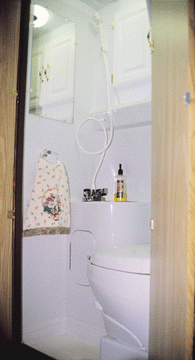 Emptying the 19½-gallon gray water and 12-gallon black water holding tanks should be simple for nearly everyone. Thanks to remote controls located near waist height, there is no need to reach under the coach to open and close the drain valves. The drain hose is conveniently stored near the horizontal drain valve. Both holding tanks are heated.
Emptying the 19½-gallon gray water and 12-gallon black water holding tanks should be simple for nearly everyone. Thanks to remote controls located near waist height, there is no need to reach under the coach to open and close the drain valves. The drain hose is conveniently stored near the horizontal drain valve. Both holding tanks are heated.
Immediately after we picked up the coach, we went to a grain elevator and had it weighed. The fuel tank, fresh water tank, and propane tank were full, but we had not loaded any food or gear, and we exited the coach before each weighing. I was impressed with the results. The front axle, which has a gross axle weight rating of 5,200 pounds, weighed 3,980 pounds. The 8,000-pound-rated rear axle carried only 5,220 pounds. The total weight of 9,280 pounds was 1,720 pounds less than the gross vehicle weight rating of 11,000 pounds. These weights contribute to the great handling and ride of the Xcursion and allow reasonable loading of the coach without undue concern about overloading.
As often happens when weighing coaches, if the approach is not perfectly level, the individual axle weights will not equal the sum of the axle weights. This scale was very good and the results are within 1 percent of each other.
I am sure that the optional Firestone Ride-Rite suspension system and the relatively low exterior height of the coach, which is approximately 10 feet 8 inches to the top of the television antenna, plus a few more inches for the air conditioner, also contribute to the Xcursion's fine ride and handling. I purposely drove the coach through a series of "S" curves near our home. This set of curves has become my standard for testing the handling of any vehicle, and the Xcursion did nothing but please me. There was a distinct absence of body sway and rocking. Later I drove along a paved road that followed a river with all of its curves and twists. Again, the handling was superb and predictable. I never felt that the coach was being pushed too hard. At one point, a small animal ran in front of me and, since no other vehicles were near, I made a quick avoidance move. The Xcursion felt steady during this maneuver, and the animal made it safely across the road.
Because the vehicle was not completely broken in, I did not do any panic-stop testing, and luckily, did not need to make any actual panic stops. Likewise, I did not have to test the antilock properties of the braking system. However, the brake system seemed entirely competent and always stopped the coach quickly and smoothly.
When we picked up the coach, it had only 49 miles on its odometer. I immediately reset the overhead computer so that I could keep an accurate record of gasoline usage. By the time I was away from the grain elevator and out of town, it was already averaging more than 8 miles per gallon. Overall mileage was 8.5 mpg. This was on fairly flat terrain and did involve some idling time, such as at the grain elevator and in some stop-and-go traffic, but mainly was open-road driving in the 50-to-55-mile-per-hour range. According to the computer, mileage ranged between 10 and 12 miles per gallon when the coach was traveling at a steady 55 mph on slightly rolling roads. I was very impressed with that kind of mileage on a brand-new engine. I have been told, but cannot confirm, that mileage on the 8.0-liter Magnum V-10 engine may not reach its peak fuel efficiency until approximately 12,000 miles. If that is true, the eventual owner of the coach should be very happy.
Thanks to the transmission and differential, the engine was turning a very comfortable 1,500 rpm at 55 mph.
The compact size of the coach allowed us to use it for running some everyday errands. One of these errands involved picking up our car, which had been serviced at a local DaimlerChrysler dealer. The arrival of the coach generated a great amount of interest there. I was very impressed when I overheard a member of the service department say that everything on the coach seemed to be planned for ease of maintenance.
As we were preparing to return the coach to the factory, Linda commented about all of the "nice little touches" that the Xcursion has and how practically all of them are standard equipment. I couldn't agree with her more. The Xcursion, while not a luxury coach, is both pleasant and practical.
Incidentally, not until we were back at the factory did we accidentally trigger the standard Dodge security system. We had used the key fob to lock the unit and then re-entered through the coach door. Without thinking, I slid into the driver's seat and opened the door. It took just a moment to disarm the system, but it did remind us of yet another nice feature on the coach.
This 21-foot Xcursion has a base suggested retail price of $62,050. Our test coach included $2,372 in optional equipment: a GoldStar microwave oven, a Duo-Therm Penguin roof air conditioner, the Firestone Ride-Rite pump and control, an exterior shower, a Heliotrope General solar battery charger, and a class III trailer hitch. This brought the final price to $64,422, plus any destination and dealer prep charges.
Someone jokingly said that it is a good thing that everyone doesn't want the same type of motorhome; if they did, it would be hard to find our way back home when we're parked in a campground. We all want a coach that fits our needs, and, fortunately, we do have the choice of many different models with a variety of features. The Xcursion may not be the choice for large families who wish to spend extended lengths of time in the coach. But for couples or those who travel alone, the Xcursion offers the opportunity for a true motorhoming experience with all of the comfort and security we have come to expect in our coaches.
Model . . . Xcursion
Floor plan . . . XC2G
Chassis . . . Dodge
Engine . . . Magnum 8-liter, 488-cubic-inch V-10, 310 horsepower
Transmission . . . four-speed automatic
Axle ratio . . . 3.55 to 1
Tires . . . Goodyear Wrangler LT 235/85R16-E
Wheelbase . . . 163 inches
Brakes . . . four-wheel disc with ABS
Suspension . . . Firestone Ride-Rite pump and control (optional); front coil, rear leaf standard
Alternator . . . 136 amps
Batteries . . . chassis -- (1) maintenance-free, 750 cca; house -- (2) Interstate Marine/RV deep cycle, 675 cca/845 mca
Steering . . . variable assist power
Convertor . . . Magnetek, 45 amps
Electrical service . . . 30 amps
Exterior length . . . 21 feet, 3¾ inches
Exterior width . . . 96¾ inches
Interior height . . . 6 feet 4 inches
Exterior height . . . 10 feet 8 inches (without roof air conditioner)
Gross combination weight rating (GCWR) . . . 19,000 pounds
Gross vehicle weight rating (GVWR) . . . 11,000 pounds
Gross axle weight rating (GAWR) . . . front -- 5,200 pounds; rear -- 8,000 pounds
Wet weight as tested . . . (weighed with full water, fuel, and LP-gas tanks) front axle -- 3,980 pounds; rear axle -- 5,220 pounds; total -- 9,280 pounds
Payload . . . 1,720 pounds
Frame construction . . . aluminum
Insulation . . . spray urethane foam
Fresh water capacity . . . 36 gallons
Holding tank capacities . . . gray water – 19½ gallons; black water -- 12 gallons
Fuel capacity . . . 35 gallons
Fuel requirements . . . unleaded gasoline
Propane capacity . . . 16.5 gallons (60 pounds)
Water heater . . . Atwood 6-gallon with Motoraid heat exchanger
Water system . . . demand
Furnace . . . Atwood Hydro Flame, 16,000 Btus
Air conditioner . . . Duo Therm Penguin roof air, 11,000 Btus, optional
Refrigerator . . . Dometic Freedom RM 2510, 5-cubic-foot two-way
Toilet . . . Thetford Bravura
Warranty . . . chassis -- 36 months/36,000 miles; coach -- 36 months/36,000 miles on body and parts not specifically warranted by individual manufacturers.


